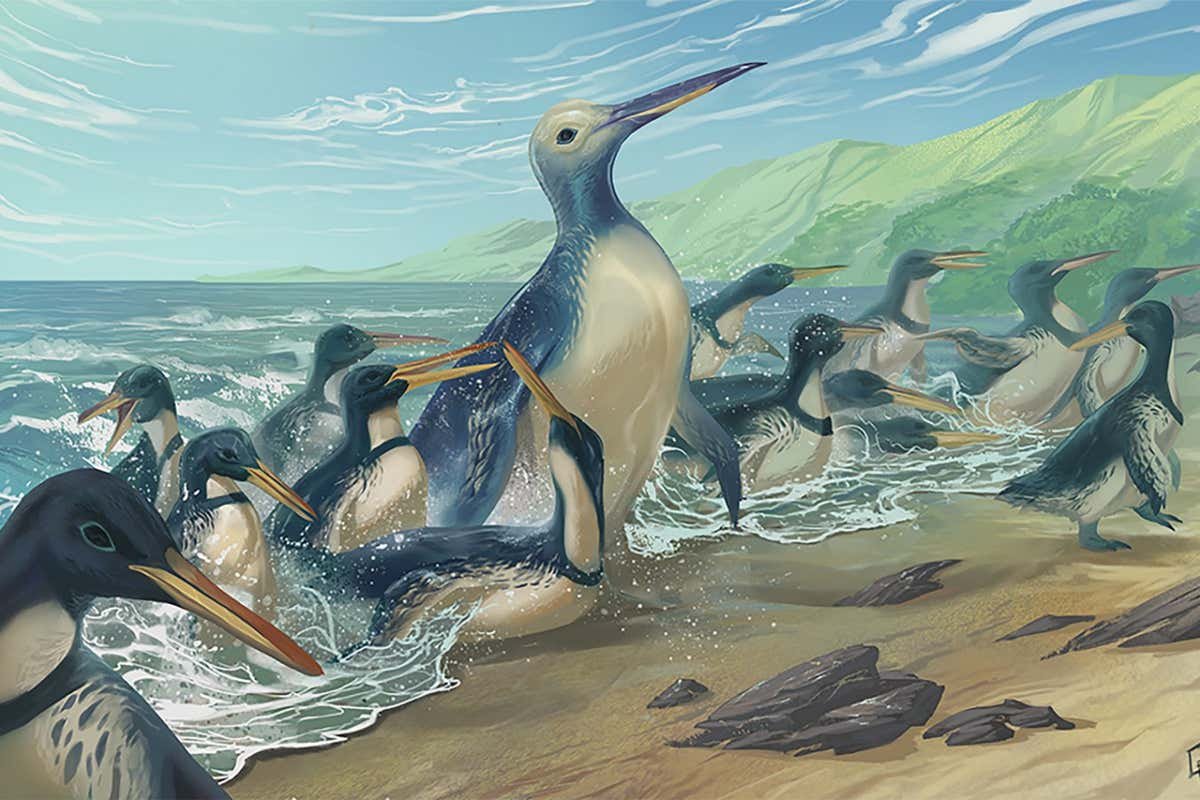
An illustration of Kumimanu fordycei (the larger, single bird) and Petradyptes stonehousei penguins on an ancient New Zealand beach
Artwork by Dr. Simone Giovanardi
Penguins come in all shapes and sizes, from the fairy penguin (Eudyptula minor) which stands at just over 30 centimetres tall to the 1-metre-high emperor penguin (Aptenodytes forsteri). But even the biggest emperors alive today would be dwarfed by the mega-penguins that roamed Earth millions of years ago. Here are the most impressive of these ancient giants.
Kumimanu fordycei
The title of the largest penguin ever documented goes to the species Kumimanu fordycei, which was first described in February 2023.
Daniel Ksepka at the Bruce Museum in Connecticut and his colleagues unearthed an unusually huge flipper bone of a penguin in southern New Zealand in 2018. “The big humerus was shocking to me,” he says. “I almost thought it was maybe some other animal.”
The team quickly determined that this belonged to a new species of penguin that lived in what is now New Zealand over 55 million years ago. The sheer size of the bone suggested that the bird probably weighed between 148 and 160 kilograms and stood around 1.6 metres tall. “The emperor penguin just looks like a child next to it,” says Ksepka.
The species was named after palaeontologist Ewan Fordyce, who made his own mega penguin discoveries in the 1970s (see below).

Skeletons of Kumimanu, Petradyptes and a modern emperor penguin
Artwork by Dr. Simone Giovanardi
Petradyptes stonehousei
Ksepka and his colleagues discovered another giant penguin alongside K. fordycei, called Petradyptes stonehousei. With an estimated mass of 50 kilograms, it was quite a bit smaller than its contemporary. Its name comes from the Greek “petra” for rock and “dyptes” for diver, while “stonehousei” was chosen to honour British polar scientist Bernard Stonehouse.
Both K. fordycei and P. stonehousei retained features seen in much earlier penguin species, such as slimmer flipper bones and muscle attachment points that look like those seen in flying birds.
“Both penguins really add to the case that penguins got their start in New Zealand,” says Ksepka.

Illustration of the extinct Palaeeudyptes klekowskii with a human and emperor penguin for scale
Nature Picture Library / Alamy
Palaeeudyptes klekowskii
While K. fordycei was the heaviest penguin, it wasn’t the tallest. That award goes to Palaeeudyptes klekowskii, dubbed the colossus penguin, which towered at 2 metres and weighed a hefty 115 kilograms.
The species lived 37 to 40 million years ago along the Antarctic coast. Its fossil, which included the longest fused ankle-foot bone, is one of the most complete ever uncovered from the Antarctic.
Owing to their larger body size, giant penguins could remain underwater longer than smaller ones. Experts reckon that a species such as P. klekowskii could have remained submerged for up to 40 minutes hunting for fish.
Pachydyptes ponderosus
Pachydyptes ponderosus is prehistoric giant that lived more recently than those already mentioned – around 37 to 34 million years ago. Based on the few bones from the species that have been recovered, in 2006 Ksepka and his colleagues put it around 1.5 metres tall with a weight of over 100 kilograms.
“We really only have parts of the flipper and shoulder, but we think it would have been quite a thick, stocky animal,” says Ksepka. “Its humerus is just so wide.”

Daniel Ksepka with a model of a Kairuku penguin
Daniel Ksepka
Kairuku
The three species that belonged to the genus Kairuku (K. grebneffi, K. waitaki and K. waewaeroa), however, were the complete opposite.
“If Pachydyptes is like a big, heavy football lineman, then you can think of Kairuku as a really tall, skinny basketball player,” says Ksepka. “They’re both really big, but in different ways.”
The first Kairuku bones were discovered by Ewan Fordyce in the 1970s, in New Zealand. All three species lived roughly 34 to 27 million years ago. The tallest, K. waewaeroa, stood at a height of around 1.4 metres and weighed around 80 kilograms.
“They were graceful penguins, with slender trunks,” says Ksepka.
Topics:

Felecia Phillips Ollie DD (h.c.) is the inspiring leader and founder of The Equality Network LLC (TEN). With a background in coaching, travel, and a career in news, Felecia brings a unique perspective to promoting diversity and inclusion. Holding a Bachelor’s Degree in English/Communications, she is passionate about creating a more inclusive future. From graduating from Mississippi Valley State University to leading initiatives like the Washington State Department of Ecology’s Equal Employment Opportunity Program, Felecia is dedicated to making a positive impact. Join her journey on our blog as she shares insights and leads the charge for equity through The Equality Network.




